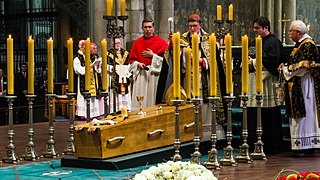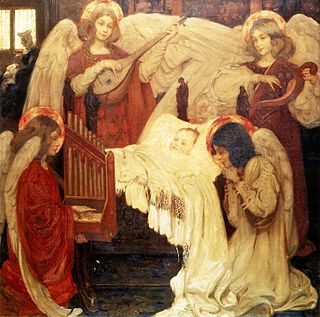
Sleep is a state of reduced mental and physical activity in which consciousness is altered and sensory activity is inhibited to a certain extent. During sleep, there is a decrease in muscle activity, and interactions with the surrounding environment. While sleep differs from wakefulness in terms of the ability to react to stimuli, it still involves active brain patterns, making it more reactive than a coma or disorders of consciousness.
A nocturnal emission, also known as a wet dream, sex dream, nightfall, or sleep orgasm, is a spontaneous orgasm during sleep that includes ejaculation for a male, or vaginal lubrication and/or an orgasm for a female.

Shema Yisrael is a Jewish prayer that serves as a centerpiece of the morning and evening Jewish prayer services. Its first verse encapsulates the monotheistic essence of Judaism: "Hear, O Israel: YHWH is our God, YHWH is one", found in Deuteronomy 6:4.

An invocation may take the form of:

Sleep hygiene is a behavioral and environmental practice developed in the late 1970s as a method to help people with mild to moderate insomnia. Clinicians assess the sleep hygiene of people with insomnia and other conditions, such as depression, and offer recommendations based on the assessment. Sleep hygiene recommendations include: establishing a regular sleep schedule; using naps with care; not exercising physically or mentally too close to bedtime; limiting worry; limiting exposure to light in the hours before sleep; getting out of bed if sleep does not come; not using bed for anything but sleep and sex; avoiding alcohol as well as nicotine, caffeine, and other stimulants in the hours before bedtime; and having a peaceful, comfortable and dark sleep environment. However, as of 2021, the empirical evidence for the effectiveness of sleep hygiene is "limited and inconclusive" for the general population and for the treatment of insomnia, despite being the oldest treatment for insomnia. A systematic review by the AASM concluded that clinicians should not prescribe sleep hygiene for insomnia due to the evidence of absence of its efficacy and potential delaying of adequate treatment, recommending instead that effective therapies such as CBT-i should be preferred.
The Ferber method, or Ferberization, is a technique invented by Richard Ferber to solve infant sleep problems. It involves "sleep-training" children to self-soothe by allowing the child to cry for a predetermined amount of time at intervals before receiving external comfort.

Now I lay me down to sleep is a Christian children's bedtime prayer from the 18th century.

A bedtime story is a traditional form of storytelling, where a story is told to a child at bedtime to prepare the child for sleep. The bedtime story has long been considered "a definite institution in many families".

A Christian child's prayer is Christian prayer recited primarily by children that is typically short, rhyming, or has a memorable tune. It is usually said before bedtime, to give thanks for a meal, or as a nursery rhyme. Many of these prayers are either quotes from the Bible, or set traditional texts.
Actigraphy is a non-invasive method of monitoring human rest/activity cycles. A small actigraph unit, also called an actimetry sensor, is worn for a week or more to measure gross motor activity. The unit is usually in a wristwatch-like package worn on the wrist. The movements the actigraph unit undergoes are continually recorded and some units also measure light exposure. The data can be later read to a computer and analysed offline; in some brands of sensors the data are transmitted and analysed in real time.

Matthew 7:7–8 are the seventh and eighth verses of the seventh chapter of the Gospel of Matthew in the New Testament and is part of the Sermon on the Mount. These verses begin an important metaphor generally believed to be about prayer.
Parasomnias are a category of sleep disorders that involve abnormal movements, behaviors, emotions, perceptions, and dreams that occur while falling asleep, sleeping, between sleep stages, or during arousal from sleep. Parasomnias are dissociated sleep states which are partial arousals during the transitions between wakefulness, NREM sleep, and REM sleep, and their combinations.

Absolution of the dead is a prayer for or a declaration of absolution of a dead person's sins that takes place at the person's religious funeral.

"Matthew, Mark, Luke and John", also known as the "Black Paternoster", is an English children's bedtime prayer and nursery rhyme. It has a Roud Folk Song Index number of 1704. It may have origins in ancient Babylonian prayers and was being used in a Christian version in late Medieval Germany. The earliest extant version in English can be traced to the mid-sixteenth century. It was mentioned by English Protestant writers as a "popish" or magical charm. It is related to other prayers, including a "Green" and "White Paternoster", which can be traced to late Medieval England and with which it is often confused. It has been the inspiration for a number of literary works by figures including Henry Wadsworth Longfellow and musical works by figures such as Gustav Holst. It has been the subject of alternative versions and satires.

Psalm 17 is the 17th psalm of the Book of Psalms, beginning in English in the King James Version: "Hear the right, O LORD, attend unto my cry". In the Greek Septuagint and the Latin Vulgate, it is psalm 16 in a slightly different numbering system, "Exaudi Domine iustitiam meam". Its authorship is traditionally assigned to King David.

Psalm 132 is the 132nd psalm of the Book of Psalms, beginning in English in the King James Version: "LORD, remember David, and all his afflictions". In the slightly different numbering system used in the Greek Septuagint version of the bible and in the Latin Vulgate, this psalm is Psalm 130. In Latin, it is known as "Memento Domine David".
Cognitive behavioral therapy for insomnia (CBT-I) is a technique for treating insomnia without medications. Insomnia is a common problem involving trouble falling asleep, staying asleep, or getting quality sleep. CBT-I aims to improve sleep habits and behaviors by identifying and changing the thoughts and the behaviors that affect the ability of a person to sleep or sleep well.
Sleep training is a set of parental intervention techniques with the end goal of increasing nightly sleep in infants and young children, addressing “sleep concerns”, and decreasing nightime signalling. Although the diagnostic criteria for sleep issues in infants is rare and limited, sleep training is usually approached by parent(s) or caregivers self indentifying supposed sleep issues.

Behavioral sleep medicine (BSM) is a field within sleep medicine that encompasses scientific inquiry and clinical treatment of sleep-related disorders, with a focus on the psychological, physiological, behavioral, cognitive, social, and cultural factors that affect sleep, as well as the impact of sleep on those factors. The clinical practice of BSM is an evidence-based behavioral health discipline that uses primarily non-pharmacological treatments. BSM interventions are typically problem-focused and oriented towards specific sleep complaints, but can be integrated with other medical or mental health treatments. The primary techniques used in BSM interventions involve education and systematic changes to the behaviors, thoughts, and environmental factors that initiate and maintain sleep-related difficulties.

Bedtime procrastination is a psychological phenomenon that involves needlessly and voluntarily delaying going to bed, despite foreseeably being worse off as a result. The causes of bedtime procrastination vary from losing sight of the time to staying up later than desired in an attempt to have control over the night due to a perceived lack of influence over events during the day. This latter phenomenon has recently been called revenge bedtime procrastination. The term originated on the Chinese social media platform Weibo in 2014. Bedtime procrastination has been linked to shorter sleep duration, poorer sleep quality and higher fatigue during the day.














